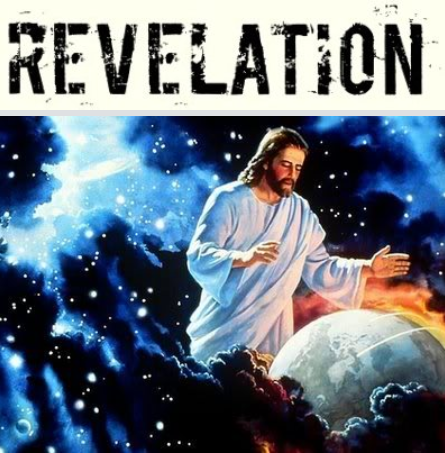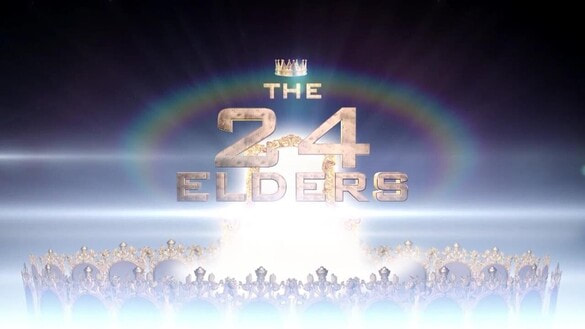Revelation 4:1-11
Lesson 474
Read both the "King James Bible" and the "New Living Translation."
In this lesson:
Chapter one was about things that have been.
Chapters two and three were about things that are.
Chapters 4-22 are about things that will be.
In this chapter, we get a glimpse at God's glory.
John sees heaven (4:1).
God's throne (4:2-3).
Twenty-four elders (4:4) and four beasts (4:6-11).
Chapter one was about things that have been.
Chapters two and three were about things that are.
Chapters 4-22 are about things that will be.
In this chapter, we get a glimpse at God's glory.
John sees heaven (4:1).
God's throne (4:2-3).
Twenty-four elders (4:4) and four beasts (4:6-11).
By an unknown artist.
Who are the -
Twenty-four elders -
Some scholars believe the twenty-four elders represent the twelve tribes of Israel and the twelve apostles. That is, the believing Jews of The Old Testament and the saved Gentiles of the New. Other scholars teach that they stand for the twenty-four orders of Levite priests selected by King David to lead Israel in worship (1 Chronicles 24-25). Still others are convinced the twenty-four elders depict the Christian church as saved by the blood of Jesus (Revelation 5:8-10). Another opinion holds that they are twenty-four high-ranking angels. John tells us they are dressed in white (representing purity) and wearing gold crowns (4:4).
The four beasts -
These are heavenly creatures who lead others in worship and praise God in song (4:8-9). They have nothing in common with the beast (Satan's agent) that we'll meet in verse 13:1. Some believe "the four beasts" is a poor translation from the original transcript. They say a better translation would be "the four creatures" or "the four living ones."
There are too many interpretations of the meaning of each beast to cover here. The most common comes from Hebrew folklore, which held that these four animals represent God's creation, with the lion being the strongest wild animal, the calf or ox (Ezekiel 1:10) being the strongest domesticated animal, the eagle the strongest bird, and man the strongest of all. Others believe that the lion symbolizes strength and courage, the calf patience and loyalty, the eagle sovereignty, and man represents wisdom.
Still another interpretation is that the four beasts represent "the four standards or ensigns of the four divisions of the tribes in the Israelitish camp, as they are described by Jewish writers. The first living creature was like a lion; this was, say the rabbins, the standard of Judah on the east, with the two tribes of Issachar and Zabulon. The second, like a calf or ox, which was the emblem of Ephraim who pitched on the west, with the two tribes of Manasseh and Benjamin. The third, with the face of a man, which, according to the rabbins, was the standard of Reuben who pitched on the south, with the two tribes of Simeon and Gad. The fourth which was like a flying (spread) eagle, was, according to the same writers, the emblem on the ensign of Dan who pitched on the north, with the two tribes of Asher and Naphtali."
(Adam Clarke's Commentary).
Notice the similarities (right down to the rainbow) between John's vision and Ezekiel's vision seven hundred years earlier (Ezekiel 1:1-28).
Twenty-four elders -
Some scholars believe the twenty-four elders represent the twelve tribes of Israel and the twelve apostles. That is, the believing Jews of The Old Testament and the saved Gentiles of the New. Other scholars teach that they stand for the twenty-four orders of Levite priests selected by King David to lead Israel in worship (1 Chronicles 24-25). Still others are convinced the twenty-four elders depict the Christian church as saved by the blood of Jesus (Revelation 5:8-10). Another opinion holds that they are twenty-four high-ranking angels. John tells us they are dressed in white (representing purity) and wearing gold crowns (4:4).
The four beasts -
These are heavenly creatures who lead others in worship and praise God in song (4:8-9). They have nothing in common with the beast (Satan's agent) that we'll meet in verse 13:1. Some believe "the four beasts" is a poor translation from the original transcript. They say a better translation would be "the four creatures" or "the four living ones."
There are too many interpretations of the meaning of each beast to cover here. The most common comes from Hebrew folklore, which held that these four animals represent God's creation, with the lion being the strongest wild animal, the calf or ox (Ezekiel 1:10) being the strongest domesticated animal, the eagle the strongest bird, and man the strongest of all. Others believe that the lion symbolizes strength and courage, the calf patience and loyalty, the eagle sovereignty, and man represents wisdom.
Still another interpretation is that the four beasts represent "the four standards or ensigns of the four divisions of the tribes in the Israelitish camp, as they are described by Jewish writers. The first living creature was like a lion; this was, say the rabbins, the standard of Judah on the east, with the two tribes of Issachar and Zabulon. The second, like a calf or ox, which was the emblem of Ephraim who pitched on the west, with the two tribes of Manasseh and Benjamin. The third, with the face of a man, which, according to the rabbins, was the standard of Reuben who pitched on the south, with the two tribes of Simeon and Gad. The fourth which was like a flying (spread) eagle, was, according to the same writers, the emblem on the ensign of Dan who pitched on the north, with the two tribes of Asher and Naphtali."
(Adam Clarke's Commentary).
Notice the similarities (right down to the rainbow) between John's vision and Ezekiel's vision seven hundred years earlier (Ezekiel 1:1-28).
Study Tip:
Reading Bible passages a second time helps reinforce lessons learned and catch essential points you might have missed with the first read.
Reading Bible passages a second time helps reinforce lessons learned and catch essential points you might have missed with the first read.











